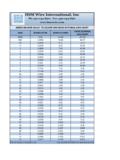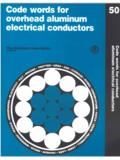Transcription of Building Easitrac Turnouts - 2mm
1 Building Easitrac Turnouts This material is part of the forthcoming 2MM Track Handbook. As it is likely to be several months before the Handbook is published the committee felt that in view of the current interest in Easitrac it would be useful to make this part available on the web. Only the sections of the Handbook that relate to Easitrac turnout construction are reproduced here. The Handbook will be considering four methods of turnout construction .The techniques that are common to all of them will be in a separate chapter. The relevant parts of that chapter are also available for download and are necessary for a complete understanding of this material. References to Chapter 5 in the text refer to this document Please recognise that it is part of work in progress and may be refined before final publication and that there are occasional references to material not provided here.
2 As editor I would welcome comments on anything in this material including errors, additional material that would be helpful and particularly areas that are not clear. Email me at: Geoff Jones Pointwork Throughout these sections we have used the term timbers to refer to the sleepers in pointwork. This is the term used by permanent way men. For the same reason we also refer to crossings not frogs (American) and switches or switch blades not point blades. The procedures outlined here are not the only ways of Building Turnouts . However, they do ensure that everything fits correctly and, provided your workmanship is clean and neat, they will work properly. There are two critical areas in a turnout: the switches and the crossing: The switch blades must fit snugly against the stock rails.
3 If they don't then wheel flanges may snag against them and that often leads to derailment. We explain in chapter 5 how to file a switch to a suitable point and how to arrange the joggle for it to fit snugly or how to file the tip of the switch if you don't use a joggle. At the crossing there is a gap in the rails where they cross. If the crossing is not aligned properly or if the check rails are incorrectly placed wheels can hit the nose of the crossing or even start to run up the wrong side of it. That, needless to say, inevitably leads to derailment. The crossing assembly jig described in chapter 5 is a very useful tool that makes it much easier to produce a correctly aligned crossing. We strongly recommend that you use one and the instructions here assume that you do.
4 1. Do be sure that you understand how the correct alignment and positioning of these components is being achieved by the methods described here before you adopt a different approach. The use of a template as a guide is always very helpful for getting parts where they belong but the final alignment must always be done with gauges. Templates are very helpful to assist you in placing the rails but the final precision must come from gauges. Gauges combined with an appropriate order of assembly are essential. We recommend Building all pointwork over a template unless you are using an Easitrac milled base, where a different approach, which is explained hers, is necessary. See the section on crossings together with Fig 12 in Chapter 2 for an explanation of the working of a crossing which will help you to understand what is needed.
5 Before you Start We discuss the basic issues of electrical connections in chapter 7; however, there are some matters which must be dealt with while you are Building the track or, in some cases, before. It is difficult to make an unobtrusive electrical connection to the track once it is laid and even more difficult after it is ballasted. Generally the least visible place to connect the wires is the bottom of the rails where the connection and the wire will be largely hidden by the ballast. We recommend always making two connections to every piece of rail. Then if one fails there is no need to make a messy and obtrusive repair. If you build your track on the workbench before laying it there are few problems. Simply solder two wires to every piece of rail once the track panels are complete and feed the wires through holes in the baseboard as you lay track.
6 If you build in situ you might consider connecting wires to each piece of rail and feeding them through the baseboard before you fix the rail. There are some specific suggestions about this for Easitrac milled base Turnouts in the construction section below. Use of Cast Brass Track Base 1-178. As well as the standard plastic track bases lost wax cast brass bases for BH track are also available. The principal use of these is to provide additional strength usually at baseboard joints and in areas where rail creep is a possibility. They can also be used to make electrical connections, but this is really only worthwhile where they are already required for strength or where soldering to the rail is impractical. Issues with Easitrac not found with Other Methods Before embarking on Building Easitrac pointwork, particularly if you have previous experience of soldered pointwork in any scale you should understand the limitations of an all plastic system.
7 2. Rail is held in small plastic chairs and these, interestingly, suffer from some of the same sort of problems as prototype chairs: Common chairs are very effective at maintaining the gauge but they are less effective at preventing the rails creeping along the length of the track. Slide chairs on Turnouts do not have jaws on the inside as the switch rails must be able to close against the stock rails. This could allow the stock rails to move under gauge. Generally creep is not a problem but it can be in pointwork where the switch rails are short and are typically restrained by no more than about a dozen chairs. On prototype Turnouts creep is prevented by a restraining link that anchors a switch to its adjacent stock rail fig 1. On Easitrac Turnouts this can be resolved by gluing the rail to the chairs with cyano.
8 In practice once the track is painted the paint has the same effect as glue. However painting is best not carried out until the track has been thoroughly tested so cyano should be used as an interim measure. Fig 1 Switch rail anchor on a BH turnout An alternative method is to use sections of cast brass sleepers for one of the timbers of the switches. Unfortunately this is not a particularly easy option as the curved switch rail is not at right angles to the timbers, although some are close enough on Turnouts sharper than B8. The use of equalised timbers, which are set at right angles to the centre line of the turnout (see chapter 2), will make this easier. This is only feasible for ABS sleeper strip pointwork built in situ where the short length of brass sleeper can be glued down immediately.
9 Templot is the only source of templates showing equalised timbers. Creep can also create problems with electrical gaps where the rail movement may close the gaps creating short circuits or energising locos that are supposed to be isolated. It can be caused on models by temperature variations or by vigorous track cleaning. Usually painting the track will anchor the rails firmly enough to prevent this, but on layouts subject to extreme temperature variations more complex measures may be necessary. Cast brass sleepers or a soldered PCB sleeper either side of a critical gap will probably be adequate for this. Any short lengths of rail which could cause electrical problems should be fixed with cyano. 3. Maintaining the gauge around slide chairs on the prototype is achieved by bolting the rails to the chairs.
10 See fig 1 in chapter 5. The simplest solution to this is again to use glue. After a turnout has been built put cyano around the outside of each switch chair that has had its inner jaw removed. A much stronger solution is as follows: Fix the stock rail in position without those slide chairs that will need their inner jaws removing (7 for an A switch, 8 for B). Detach the slide chairs from their sprue, cut away the inside jaw of each chair with a scalpel and smooth any remaining roughness. Place a spot of epoxy adhesive on the inside of each chair jaw and slide it under the rail. If necessary place a weight on the rail to ensure that it sits firmly on the slide chairs. When the epoxy is cured stick the slide chairs to the timbers with solvent as usual with a triangular track gauge in position to ensure the correct gauge is maintained.



